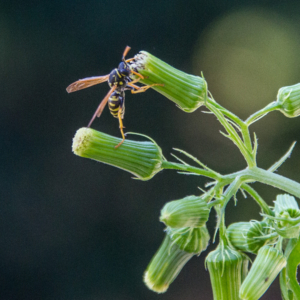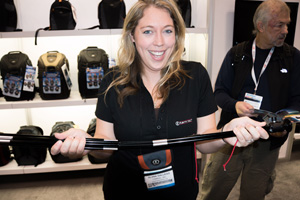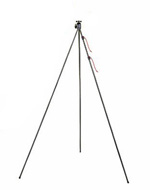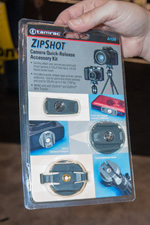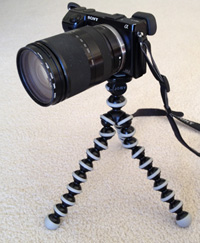Online Magazine
Recent Posts
- Safeguard your Cellphone Photos
- Black & White to Color – Instantly
- Wearing Many Hats
- Video Roundup
- Rescuing Your Blurry Pictures
- Showing Their Age
- What is Your Angle?
- Panorama Photos
- Humorous Photos
- Close Ups
- Fisheye Pictures
- Photo Antiquities
- Printing Big
- Appreciating Scale
- Celebrity Sightings
Tags
More Places to Go
- Free "How-To" Books “How To” books for popular cameras 0
- Vist Us on Facebook keep in touch with us on Facebook 2
Archives
- July 2023 (1)
- March 2023 (2)
- February 2023 (1)
- December 2022 (1)
- October 2022 (1)
- September 2022 (8)
- August 2022 (9)
- July 2022 (1)
- June 2022 (1)
- June 2021 (1)
- May 2021 (1)
- March 2021 (5)
- February 2021 (4)
- January 2021 (2)
- April 2019 (1)
- March 2019 (1)
- February 2019 (1)
- October 2018 (2)
- April 2018 (1)
- March 2018 (4)
- February 2018 (1)
- November 2017 (1)
- August 2017 (1)
- June 2017 (1)
- April 2017 (1)
- March 2017 (5)
- February 2017 (2)
- January 2017 (1)
- October 2016 (1)
- September 2016 (1)
- August 2016 (1)
- July 2016 (1)
- May 2016 (1)
- April 2016 (1)
- March 2016 (2)
- February 2016 (1)
- January 2016 (2)
- December 2015 (1)
- November 2015 (1)
- October 2015 (3)
- April 2015 (1)
- March 2015 (5)
- February 2015 (1)
- January 2015 (4)
- December 2014 (2)
- November 2014 (5)
- October 2014 (2)
- September 2014 (1)
- August 2014 (2)
- July 2014 (1)
- May 2014 (1)
- April 2014 (5)
- March 2014 (5)
- December 2013 (2)
- November 2013 (18)
- October 2013 (1)
- September 2013 (1)
- August 2013 (1)
- July 2013 (1)
- June 2013 (3)
- May 2013 (1)
- April 2013 (2)
- March 2013 (1)
- February 2013 (1)
- January 2013 (1)
- December 2012 (1)
- November 2012 (2)
- October 2012 (2)
- September 2012 (5)
- August 2012 (2)
- July 2012 (1)
- June 2012 (1)
- May 2012 (1)
- April 2012 (4)
- March 2012 (1)
- February 2012 (1)
- January 2012 (3)
- December 2011 (1)
- November 2011 (3)
- October 2011 (1)
- September 2011 (2)
- August 2011 (2)
- June 2011 (3)
- May 2011 (4)
- April 2011 (8)
- March 2011 (8)
- February 2011 (10)
- January 2011 (6)
- December 2010 (11)
- November 2010 (14)
- October 2010 (6)
- September 2010 (12)
- August 2010 (2)
- July 2010 (4)
- June 2010 (3)
- May 2010 (1)
- April 2010 (1)
- March 2010 (2)
- February 2010 (1)
- January 2010 (1)
- December 2009 (1)
- November 2009 (2)
- October 2009 (2)
- September 2009 (1)
- August 2009 (3)
- July 2009 (2)
- June 2009 (1)
- May 2009 (2)
- April 2009 (1)
- March 2009 (2)
- February 2009 (1)
- January 2009 (3)
Close Ups
16th September 2022
With the naked eye, it’s often difficult or impossible to see the detail of smaller objects.
Most modern cameras and cellphones have lenses that can focus close enough to capture some of this detail.
When shooting up close I try to have good lighting, careful focus and a steady hand (or better yet a tripod) to keep the images as in focus as possible.
Below are some of the pictures that I’ve been able to photograph up close without using any special camera equipment.
Whatever type of camera that you’re using you’re probably equipped to take close ups. It not only interesting to see your subjects up close with lots of detail, it’s fun too.
Written by: Arnie Lee
PhotoPlus Expo – ZipShot
12th November 2013
Tamrac’s very compact tripod
For photographers who like to travel light, Tamrac has introduced the ZipShot.
For more information about Tamrac’s ultra-light tripod see ZipShot
Written by: Arnie Lee
A Little Help from a Steady Hand
01st November 2013
The Case For a Tripod
I’ve never been a big user of tripods. I have nothing against using them and in fact I own several of them. I use a tripod mostly around the studio when shooting still life and products. But when I’m shooting out of the studio, I rarely take one along. I like the lightweight freedom and try to minimize the amount of gear that I carry. And I am not very patient trying to set up for a shot. When traveling by airplane a tripod is just not very convenient.
During daylight, the canyon is dimly lit yet remains easily and comfortably walkable. Photographically, there is enough light in some areas to shoot handheld. However to capture images of some of the more dimly lit rock faces, you’ll need to use longer exposure times e.g. 1/2 second or longer. Not many of us can handhold at these slower shutter speeds.
Knowing this ahead of time, I mounted one of my cameras on the Gorillapod. As you can see from its short legs, when placed on the ground it’s not convenient to use unless you’re kneeling down. In the canyon, the rocks are the perfect surface on which to rest this mini tripod.
For much of the tour, I’m looking upwards towards the light entering the canyon from above. To capture a long exposure, I twisted the legs to conform with the contour of an adjacent rock surface to make a “rock steady” platform. I used this technique for exposures up to two full seconds.
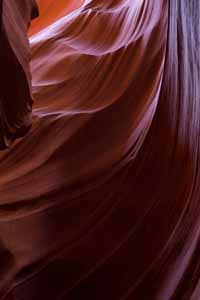 |
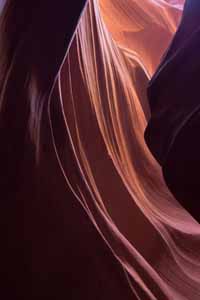 |
 |
If you too are a non-tripod guy like me, you might find it useful during one of these outings to include a very portable tripod. There are several brands of portable steadying devices. You can find out more about the one I used at Joby Gorillapod
If you’re interested in visiting these amazing slot canyons located near Page, Arizona, you’ll want to book a tour with one of the five Navajo owned companies. I chose an extended photo tour 2-1/2 hours instead of the normal 1-1/2 hour tours. I booked through Antelope Canyon Tours and our tour guide Rosie was splendid in pointing out many of the colorful formations and giving us photo shooting tips.
Written by: Arnie Lee
Newer Posts »
